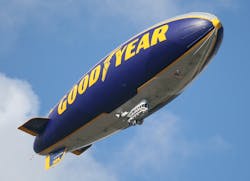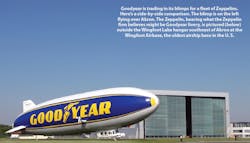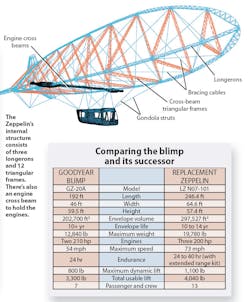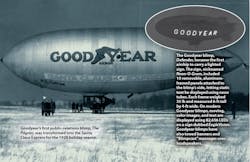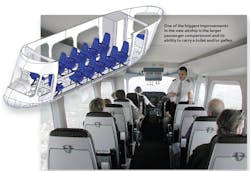Goodyear upgrades from blimps to Zeppelins
The Goodyear Tire & Rubber Co., Akron, Ohio, will begin replacing its fleet of blimps with Zeppelin LZ N07-101s beginning in 2013 as the blimps begin to age out. Zeppelins will then make up the firm’s entire U. S. airship fleet by about 2017. (Goodyear also has a blimp based in China.) According to the company, the new airships, which can be called Zeppelins or dirigibles, will fly faster, carry more passengers, and be equipped with state-of-the-art avionics and flight controls. Each of the three dirigibles, along with tech support, will cost about $21 million.
Trading up
The new Zeppelins will be semirigid airships, meaning a 1.2-ton aluminum and carbon-fiber framework will support the outer skin, engines, gondola (the passenger and crew compartment), and the three airfoils that form the inverted “Y” pattern that make up the tail structure. The outer envelope or skin contains the lifting gas, helium. There are no individual cells or a separate inner envelope. The skin is a laminate of polyester fabric and Tedlar, a film from DuPont, with a polyurethane coating.
For power, the Zeppelins will rely on three 200-hp Textron Lycoming IO-360 piston engines. Two are mounted in nacelles on each side of the airship, about a third of the way back from the nose. Both side engines employ variable-pitch “puller” props that can mechanically swivel from up 0 to 120°. So between the variable-pitch prop, which lets the prop push or pull in varying amounts, and the swivel action, the pilot has thrust control over the airship’s pitch and roll. The third engine is on the rear of the airship, behind the tail. Its prop, usually acting as a pusher, swivels up from 0 to 90°. The rear engine also carries a secondary prop pointed sideways and dedicated to yaw control. The lateral prop gives a hovering Zeppelin the ability to do a zero-radius or pivot turn.
The aircraft is actually a bit heavier than the air it displaces, but its three tail fins each generate more than enough lift to keep the craft airborne, as long as speed is kept at 15 knots or more. The rear fins also have 345 ft2 of directional-control surfaces. So for takeoffs and landing, and at airspeeds under 15 knots, the side engines generate and control lift while the rear one handles yaw and rotation.
When instantaneous lift is needed, for whatever reason, the airship carries 25-lb bags of lead shot and 1,540 lb of water as ballast. The bags and water can be dropped as needed to make the airship lighter and give it lift.
Onboard electricity is supplied by three generators and three lead-acid batteries. If the new programmable LED displays that show full-color moving images day or night are installed, an additional 80-kW generator will also be installed. The rectangular displays, each of which covers 1,636 ft2 and contains 22,4000 pixels, adds 880 lb to each side of the airship.
The ship carries a gas tank for each engine: an 84-gallon tank for the aft engine, and two 111-gallon tanks for the side engines. They are interconnected so the pilot can move fuel between tanks to trim and balance the craft. For extended flights, a pair of 185-gallon tanks loaded into the gondola, along with a larger oil supply for the engines and an HF-radio and SATCOM package, let the Zeppelin cruise for up to 45 hr.
Trim and balance are also maintained by four ballonets inside the gas envelope. They can carry a total of 65,000 ft3 of air, which can be shifted automatically or manually among the four ballonets for balance, as well as vented to the outside or refilled while in flight. This lets the Zeppelin keep its shape despite changes in altitude, outside temperature, and pressure.
The new airship will boast a single-pilot, glass-cockpit with three main screens. The center screen will include engine indicators and crew alerts and will show oil pressure, fuel in each tank, hydraulic pressure, and the three engines’ rpm. The right screen, a multifunction display, can show GPS info, up-to-date weather maps and data, moving maps, video from the airship’s camera, and information on the optional onboard sign. The left screen will show important flight info, such as altitude and direction. The cockpit is also said to have better outside visibility, compared to the blimps, giving the pilot a better look at what’s happening outside.
Getting to the U. S.
Due to the distance between Akron and Friedrichshafen, Zeppelins’s home base in Germany, the three new airships cannot be safely and easily flown to their new homes in the U. S. Instead, the airships will be subassembled and shipped to Akron. There, each airship will be fully assembled by a joint Goodyear-Zeppelin team, a task that should take 10 months and involve crews of four to 10 workers. The new airships will take over the blimp hangars, and Goodyear’s U. S. airship bases will be able to handle all the maintenance requirements, given some technical support from Zeppelin. Goodyear has airship bases and blimps in three U. S. cites: Akron, Ohio; Carson, Calif.; and Pompano Beach, Fla.
Goodyear will transition its blimp pilots to the new aircraft with a four-month training cycle, and its pilot staffing levels will remain the same.
The first airship should arrive in 2013 and be assembled, tested, and operational by 2014. The third and last should be flying in 2019.
Where did they get that name?No one is sure how the blimp got its name, but there are few stories that try to explain it. One of the most well-accepted versions is that Lt. Cunningham, a member of Great Britain’s Royal Navy Air Service and commanding officer of the air station at Capel, England, during World War I, came up with the term as he was inspecting the station and its lighter-than-air flying machines. It’s said he flicked his thumb against the taut fabric of His Majesty’s Airship SS-12, which created a noise. Lt. Cunningham mimicked the sound, saying, “blimp,” and the airship got its name. Another version says that as the Brits were experimenting and developing lighter-than-air vehicles during World War I, they came up with a nonrigid aircraft called the A-limp and a follow-on version called the B-limp. The second was chosen as the namesake for the entire family of flying gasbags. |
A primer on airships
Nonrigid airships, or blimps, rely solely on the internal pressure of the lifting gas (helium) to maintain the envelope’s shape. The only stiff or rigid parts of the structure are the gondola and tail fins. There is no internal framework.
Semirigid airships usually have a rigid lower keel and a pressurized envelope above that. The keel can attach to the envelope or hang beneath it.
Rigid airships have internal frames. This rigid structure, traditionally an aluminum alloy, maintains the shape of the airship. In general, rigid airships are only efficient if they’re longer than 360 ft. That’s because airships need low weight-to-volume ratios. For small airships, a solid frame is just too heavy.
